It looks like you're using an Ad Blocker.
Please white-list or disable AboveTopSecret.com in your ad-blocking tool.
Thank you.
Some features of ATS will be disabled while you continue to use an ad-blocker.
share:
This one has it all. Adultery, murder, alchemy, castrations, secret societies, real decaying corpses, amazing (almost impossible) marble sculptures,
and more. This is the Sansevero Chapel in Italy.
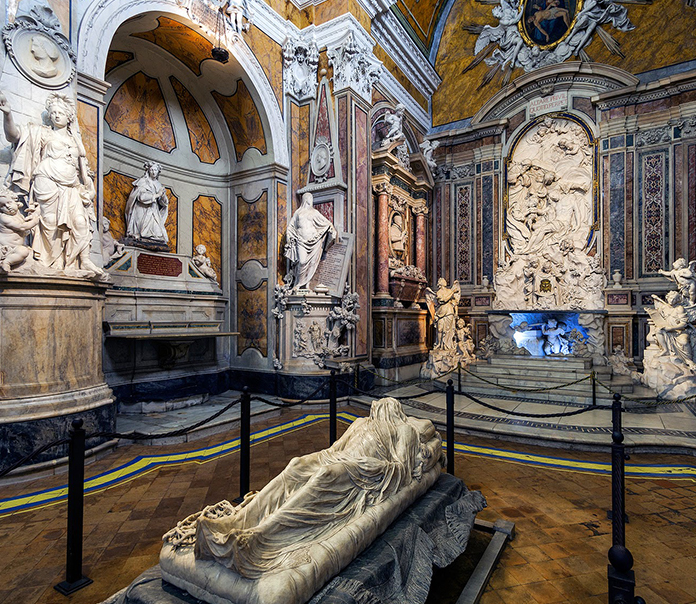
Before getting into the chapel itself lets take a look at the man who designed it all. He has the conspiracy trifecta. A Jesuit, Rosecrucian, and a Mason. Raimondo di Sangro, the “Sorcerer Prince”
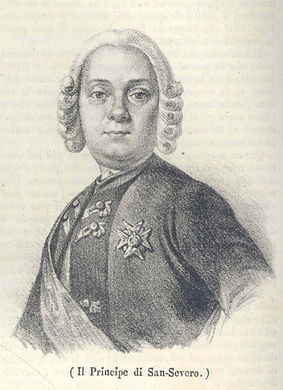
This guy was obsessed with alchemy, some even say he could create blood out of water or out of thin air. He dabbled with human sacrifice and human experimentation.
But that isn't the worst of it. This next part is truly disgusting human behavior.
Now for the temple.
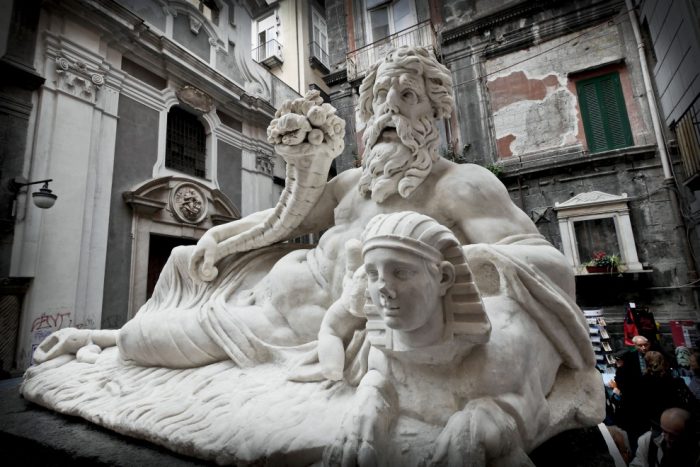
The marble statues contained are amazing. They are so well done that some people including art buffs and art media have been fooled by the work. Some say it is impossible to chisel such things in marble and say it must have been done through and alchemy process. Regardless, I find these statues amazing.
The Veiled Christ.

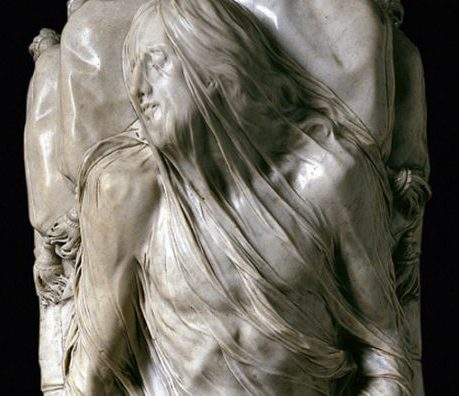

Before getting into the chapel itself lets take a look at the man who designed it all. He has the conspiracy trifecta. A Jesuit, Rosecrucian, and a Mason. Raimondo di Sangro, the “Sorcerer Prince”

From the age of 10, di Sangro was educated at the Jesuit College of Rome. In 1730, at age 20, he came back to Naples using the title “Prince of Sansevero”. He soon joined the ranks of occult secret societies.
In spite of the religious training that he had received with the Jesuits, the young man soon joined the secret brotherhood of the Rosicrucians, where he was initiated into ancient alchemic rituals, the so called “sacred art” or “king’s art” which had been handed down through the centuries from Egyptian priest to their disciples. Don Raimondo had found his life calling. While maintaining the outmost silence about “his brothers” and the teachings he was receiving (he left no documents whatsoever on the activities of the mysterious sect) the Prince radically changed his life and devoted all his time to alchemy. Vials, ovens and alembics filled the cellar of his palace and at nighttime it was not rare to see strange, colored vapors and disgusting smells coming out of the barred windows of his cellar. It was at that time that Neapolitans started labeling him a sorcerer.”
– Rino Di Stefano, Raimondo de Sangro,
the “Sorcerer” Prince
Di Sangro introduced Freemasonry to his city as he became the head of the Neapolitan Masonic Lodge. This fact, combined with his knack for presenting peculiar inventions, such as an “eternal flame” made from a chemical compound of his creation and human skull bones, only grew the legend surrounding Di Sangro.
This guy was obsessed with alchemy, some even say he could create blood out of water or out of thin air. He dabbled with human sacrifice and human experimentation.
Prince Raimondo di Sangro was known as an eccentric, enigmatic, and mystical man. He was the head of the Neapolitan Masonic lodge, the symbols of which are interspersed throughout the chapel, and was a student of numerous areas of the sciences, as well as alchemy and other mystical disciplines. He also spoke several exotic languages such as Hebrew and Arabic and was an inventor, some of his inventions of which were rather bizarre, such as a mechanized carriage with wooden horses that was said to be able to travel over both land and water.
These eccentricities led to the Prince garnering a reputation as a practitioner of wizardry and black magic, and rumors abounded that he performed sinister magical rituals, human sacrifices, and curses. It was also said that he could perform great feats of alchemy, such as creating blood out of water or even thin air, and that he used the various body parts of his sacrificed victims in his odious spells and potions. The Prince was said to lock himself away for days on end and perform demented experiments on human beings, such as reanimating the dead. These dark rumors and legends that swirled around the Prince made him into a man to be feared and avoided; a larger than life black sorcerer who could bend magical and natural forces to his will. The Prince did little to deny these rumors and it is thought that he even encouraged them.” – Brent Swancer, The Bizarre Anatomical Machines of Italy
But that isn't the worst of it. This next part is truly disgusting human behavior.
One of di Sangro’s many “hobbies” was Bel Canto, which means “beautiful singing”. Sounds good, doesn’t it? Who doesn’t appreciate beautiful singing?
However, for di Sangro, “Bel Canto” means buying little boys from impoverished parents, castrating them and forcing them to sing.
In spite of his being acquainted with the pleasures of family life and having children (…), the Prince enjoyed going around his many estates looking for young boys with beautiful voices. Usually he would find them in the church choir. Then he would “buy” them from their parents (usually poor, illiterate peasants who had many children) and had his personal physician, don Giuseppe Salerno, castrate them. He would then lock them up in the Conservatory of Jesus Christ’s Poor in Naples, where these young castrated boys started their careers as “sopranist”.
Now for the temple.
Before it was transformed by Raimondo di Sangro, the Sansevero Chapel was already the subject of bizarre rumors. It was said to have been constructed on an old temple of Isis and, to prove this fact, locals point to a massive Statue of the God of the Nile, located just around the corner from his home.

Adding to the sinister factor, the Palazzo Sansevero was the scene of a brutal murder at the end of the 16th century, when the composer Carlo Gesualdo caught his wife and her lover together and hacked them to death in their bed. Up until 1888, a passageway connected Palazzo Sansevero to the Sansevero chapel.
The marble statues contained are amazing. They are so well done that some people including art buffs and art media have been fooled by the work. Some say it is impossible to chisel such things in marble and say it must have been done through and alchemy process. Regardless, I find these statues amazing.
The Veiled Christ.

The works of art in the Sansevero Chapel are indeed unique, powerful and unsettling, forcing visitors to ask: “How did he do that”? And, when one knows the esoteric and alchemical background of the Prince, observing them leads to the question: “Was this done through an occult process?” The most compelling example of this is The Veiled Christ. Set in the middle of the chapel, this sculpture of Christ covered by a thin veiled has an unnerving quality: How was this marble sculpture made using a block of stone and a chisel? The veil is too … real.

“Completed in 1753 by Giuseppe Sanmartino and commissioned by Raimondo di Sangro, it portrays Christ deposed after crucifixion, covered by a transparent veil. This veil is rendered with such subtlety as to be almost deceiving to the eye, and the effect seen in person is really striking: one gets the impression that the “real” sculpture is lying underneath, and that the shroud could be easily grabbed and lifted.
It’s precisely because of Sanmartino’s extraordinary virtuosity in sculpting the veil that a legend surrounding this Christ dies hard – fooling from time to time even specialized magazines and otherwise irreproachable art websites.
Legend has it that prince Raimondo di Sangro, who commissioned the work, actually fabricated the veil himself, laying it down over Sanmartino’s sculpture and petrifying it with an alchemic method of his own invention; hence the phenomenal liquidness of the drapery, and the “transparence” of the tissue.” – Bizarrobazar, The Mystery of Chapel Sansevero
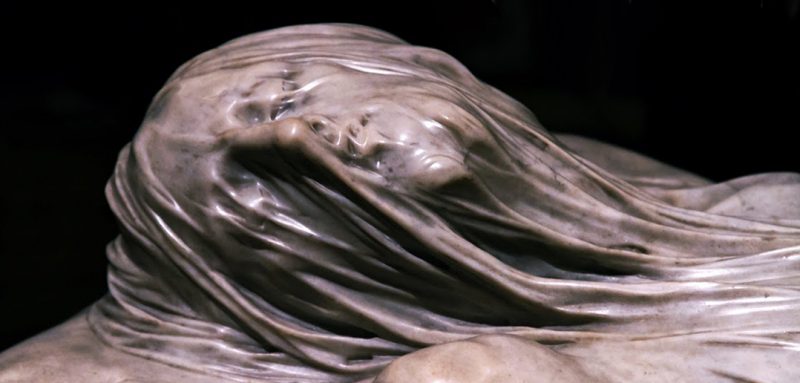
For centuries, a “black legend” surrounded this sculpture and others in the chapel that held that the Prince used a mysterious alchemical process to “marbelize” a fine cloth placed over the sculpture.
Some observers noticed a troubling detail about that sculpture: Christ appears to still be breathing.
“There may be another small “anomaly” in this Veiled Christ, as there is a slight indentation over the nostril, as if the shroud is being sucked in by breath – is this “dead Jesus” alive? Did di Sangro believe that Jesus had not died on the Cross? If so, perhaps he was not only a Mason, but a member of another, even more mysterious, order?
This isnt the only sculpture with the amazing veil work. Next to it is The Chastity.

On the left of Veiled Christ is The Chastity, a sculpture modeled after di Sangro’s mother Cecilia Caetani d’Aragona. The naked woman is covered from head to toe by a thin veil which reveals her forms in every detail. This work of art is, once again, another “supernatural” feat of sculpture. How can this effect be achieved using marble?

“The Chastity (La Pudicizia) by Corradini, with its drapery veiling the female character as if it was transparent, is another “mystery” of sculpting technique, where the stone seems to have lost its weight, becoming ethereal and almost floating. Imagine how the artist started his work from a squared block of marble, how his mind’s eye “saw” this figure inside of it, how he patiently removed all which didn’t belong, freeing the figure from the stone little by little, smoothing the surface, refining, chiselling every wrinkle of her veil.” – Op. Cit, Bizarrobazar.
Get ready for some Freemasonry.
Although the statue was modeled after di Sangro’s mother, it is clearly a tribute to the most important figure in Freemasonry: Veiled Isis.
“The veiled woman can be interpreted as an allegory of Wisdom, and the reference to the veiled Isis, special divinity of the science of initiation.” – Made in South Italy,
The Alchemist Chapel Indeed, in occult symbolism, Veiled Isis is the ultimate representation of occult mysteries where the truth is veiled to the profane until true esoteric initiation.
To the modern seeker she is the epitome of the Great Unknown, and only those who unveil her will be able to solve the mysteries of life, death, generation, and regeneration.”
– Manly P. Hall, The Secret Teachings of All Ages
Maybe some of out resident Masons can comment on those statements.
Locals claim the location of The Chastity is exactly where the Isis statue was when the temple was an Isis temple.
Accross from The Chastity is yet another amazing work called Disillusionment.
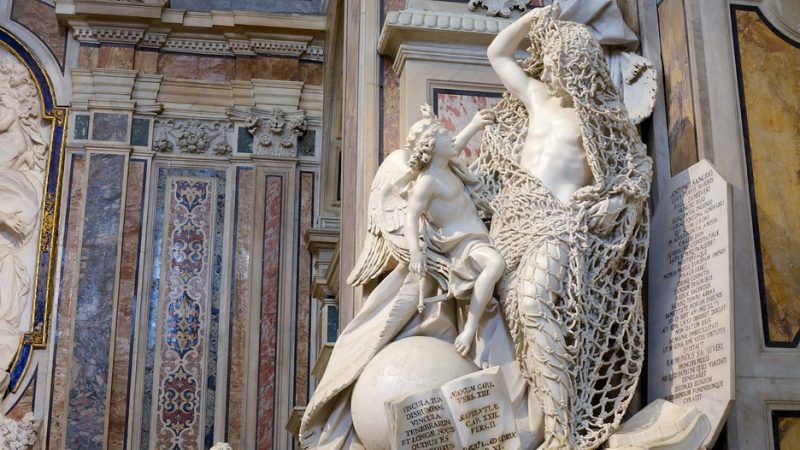
Another perplexing sculpture infused with profound symbolism. Modeled after the Prince’s father Antonio di Sangro, it depicts a man struggling to free himself from a net as he is being helped by a winged youth.
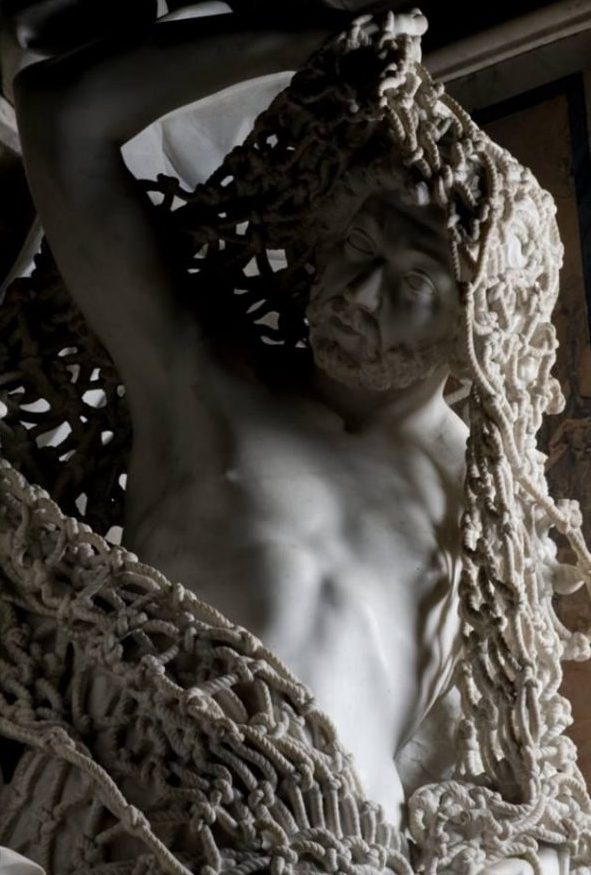
Once again, a mystery surrounds this sculpture: How can a net be sculpted over a body that appears to have been already sculpted underneath? Was an alchemical process used to achieve this astonishing result?
Not unlike The Chasity, this sculpture is an allegory for a fundamental Masonic concept: The freeing of Man using the intellect.
“Its allegorical meaning is that man is intent on freeing himself from false beliefs (the net) with the aid of the intellect (the young man).” – Rino Di Stefano, “San Severo”
Put the three together and what do you get?
these three sculptures constitute an “esoteric triangle”. With The Chastity on the left (representing the female principle), Disillusionment on the right (representing the male principle) and Veiled Christ in the middle (representing the “perfected man”), the sculptures esoterically represent the most fundamental hermetic principle: Duality merging to create a perfected being.
In occult circles, this concept is personified by Isis and Osiris uniting to create Horus – the perfect being.
Now we get creepy! Adam and Eve.
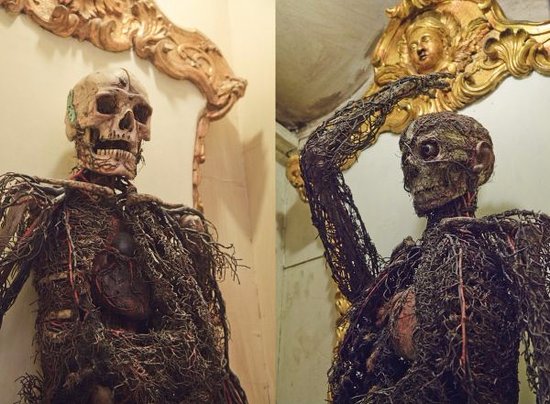
What the heck are those things might you ask? Well, they’re exactly what you’re hoping they are not. And maybe worse. This exhibit consists of two actual skeletons of a mature male and a pregnant woman. Their entire nervous system is exposed, where the arteries are colored red and the veins are colored blue.
The fetus of the pregnant woman was on also originally on display but the specimen mysteriously disappeared.
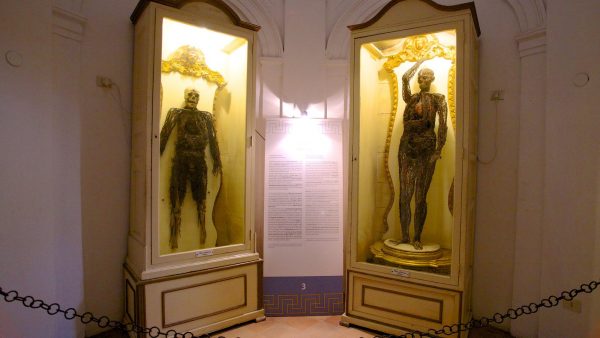
How did Raimondo di Sangro preserve the nervous system of these human remains? Well, that’s a mystery that keeps on being mysterious. And, once again, a “dark legend” surrounds these “anatomical machines”. It was indeed rumored that “Adam and Eve” were two servants of di Sangro who were injected with a substance that crystallized their nervous system – killing them in the process. Here’s a dramatic account of the legend:
Not for the squeamish:
“The Prince, just like a sorcerer, is stirring the preparation in a big cauldron. Eventually, the long-awaited reaction takes place: a mysterious liquid is ready. On the other side of the room, the two bound and gagged servants can’t even scream anymore. The man is sobbing, while the woman, even immobilized, stays vigilant and alert — perhaps the new life she carries in her womb prevents her from giving in to fear, commanding an already impossible defense. The Prince hasn’t got much time, he has to act quickly. He pours the liquid down a strange pump, then he gets close to his victims: in their eyes he sees an unnameable terror. He starts with the man, puncturing the jugular vein and injecting the liquid right into his bloodstream with a syringe. The heart will pump the preparation throughout the body, and the Prince watches the agonizing man’s face as the dense poison begins to circulate. There, it’s all done: the servant is dead. It will take two to three hours for the mixture to solidify, and surely more than a month for the putrified flesh to fall off the skeleton and the network of veins, arteries and capillaries the process turned into marble. Now it’s the woman’s turn.” – bizzarrobazar, The mysteries of Sansevero Chapel
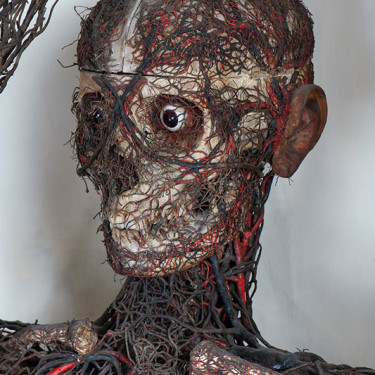
There is plenty that I left out here. Please check out this conveniently clickable link to read more about this mysterious temple.
a reply to: FauxMulder
Have you been there?
The two bodies you linked are below the chapel. They were believed to be the earliest examples of anatomical plastination but after they studied them further it was determined the veins and arteries were actually wire and wax. Still pretty cool to see though.
Have you been there?
The two bodies you linked are below the chapel. They were believed to be the earliest examples of anatomical plastination but after they studied them further it was determined the veins and arteries were actually wire and wax. Still pretty cool to see though.
a reply to: AugustusMasonicus
No, but I would love to go.
I read that about the wire and wax. Others were saying it would be impossible to recreate it so perfectly. I don't know, I would think you've got nothing but time back in the 17th century to do stuff like that. Pretty amazing either way.
No, but I would love to go.
I read that about the wire and wax. Others were saying it would be impossible to recreate it so perfectly. I don't know, I would think you've got nothing but time back in the 17th century to do stuff like that. Pretty amazing either way.
originally posted by: FauxMulder
I don't know, I would think you've got nothing but time back in the 17th century to do stuff like that. Pretty amazing either way.
I agree, whomever worked on them obviously had as much time as the sculptor, hence the fantastic attention to detail. The veiled carvings are amazing.
a reply to: FauxMulder
Considering the history and stories supplied, if it were mine I would burn it to the ground with thermite. Jesuits and Freemasons? What an unholy combination if ever there was one. No matter how "pretty" or advanced the so-called art, they are two of the "groups" I hate the most. To the outside world they may appear to be charitable and well-meaning but...well.
Star and flag in any case if only for the macabre.
Oh, and I can see nipples.
Considering the history and stories supplied, if it were mine I would burn it to the ground with thermite. Jesuits and Freemasons? What an unholy combination if ever there was one. No matter how "pretty" or advanced the so-called art, they are two of the "groups" I hate the most. To the outside world they may appear to be charitable and well-meaning but...well.
Star and flag in any case if only for the macabre.
Oh, and I can see nipples.
a reply to: FauxMulder
Very interesting and well put together thread
Do you know if Raimondo di Sangro simply attended a Jesuit school, much like many non-Jesuits, or was he actually initiated into the Society of Jesus? Attending a Jesuit school does not make one a Jesuit.
Very interesting and well put together thread
Do you know if Raimondo di Sangro simply attended a Jesuit school, much like many non-Jesuits, or was he actually initiated into the Society of Jesus? Attending a Jesuit school does not make one a Jesuit.
originally posted by: Sahabi
a reply to: FauxMulder
Do you know if Raimondo di Sangro simply attended a Jesuit school...or was he actually initiated into the Society of Jesus
I'm not entirely sure but it might be that he just attended the school. He was excommunicated by the church.
He was head of the Neapolitan masonic lodge until he was excommunicated by the Church, making an enemy of the Neapolitan cardinal Giuseppe Spinelli. The excommunication was later revoked by Pope Benedict XIV, probably on account of the influence of the di Sangro family.[1]
edit on 31-5-2017 by FauxMulder because: Osirus
Excellent thread, Faux. Thanks for putting so much effort into it, and such an amazing subject as well.
This is totally creeptastic and what ATS is fundamentally all about at it's core, great thread. It also serves as another red flag against secret
societies like "what are you guys really up to in those secret halls and chambers...?"
I don't know, take away the rumors and accusations of devilry, Raimondo di Sangro sounds more like the Da Vinci of his time.
I guess secrecy has a downside when you do amazing things.
Also, I believe that castration of young boys to preserve their singing voice was a well known practice until the late 1800's.
en.wikipedia.org...
Not saying it's a good thing, but it happened a bit.
Thanks for the beautiful thread!
I guess secrecy has a downside when you do amazing things.
Also, I believe that castration of young boys to preserve their singing voice was a well known practice until the late 1800's.
en.wikipedia.org...
Not saying it's a good thing, but it happened a bit.
Thanks for the beautiful thread!
a reply to: Unresponsible
I am honestly surprised that I've never heard of Raimondo di Sangro. Those sculptures are beyond impressive; they are amongst the greatest application of skill I've ever seen. I am especially impressed with the netted; "Disillusion". Wow.
What an awesome and amazing chapel!
(This is worth the watch!)
Sansevero Chapel Museum
I am honestly surprised that I've never heard of Raimondo di Sangro. Those sculptures are beyond impressive; they are amongst the greatest application of skill I've ever seen. I am especially impressed with the netted; "Disillusion". Wow.
What an awesome and amazing chapel!
(This is worth the watch!)
Sansevero Chapel Museum
edit on 5/31/17 by Sahabi because: (no reason given)
As an artist I have a good idea of the difficulty involved in making these veiled figures and it shows an incredible mastery of not only technique but
planning since the process involves removal of material even the slightest cut too far could ruin the effect. Master carvers also knew the rock they
would carve intimately, knowing which layers would be harder, softer, prone to chipping, more or less opacity etc. It's possible the veil itself was a
clever use of a slightly more translucent layer of stone left atop the figure which would allow light to actually penetrate down to the layer below
creating a 3D effect.
Great thread! Just when you think you've seen it all.
Great thread! Just when you think you've seen it all.
a reply to: Asktheanimals
Why can't you just accept that it was done with mystical powers, man?!?
Art shill!
Why can't you just accept that it was done with mystical powers, man?!?
Art shill!
a reply to: Shamrock6
Don't believe him.
I'm also an artist, to reach this amazing level of detail and intricacy, with this material and medium, where the slightest wrong shake will chip and break the stone, I can confidently say it's impossible.
So I agree with you, mystical powers or aliens.
Don't believe him.
I'm also an artist, to reach this amazing level of detail and intricacy, with this material and medium, where the slightest wrong shake will chip and break the stone, I can confidently say it's impossible.
So I agree with you, mystical powers or aliens.
a reply to: FauxMulder
Thanks for sharing. I'm a fan of the sculptor Gian Lorenzo Bernini, but Giuseppe Sanmartino's works are even more mind boggling.
Thanks for sharing. I'm a fan of the sculptor Gian Lorenzo Bernini, but Giuseppe Sanmartino's works are even more mind boggling.
edit on 09 11 2015 by MaxTamesSiva because: (no reason given)

Dude, his mom was hot! No wonder he sculpted her. Creepy, but sexy
a reply to: FauxMulder
I hate being that guy,......
But after doing a little research, all of the sinister aspects of the story vanish with the light of truth. I guess that's what happens when we take The Vigilant Citizen as source material.
Before I begin, I do sincerely thank you for organizing this thread and making me aware of this stunning chapel and its amazing works of art.
"Before it was transformed by Raimondo di Sangro, the Sansevero Chapel was already the subject of bizarre rumors."
Duke of Torremaggiore, Giovan (John) Francesco di Sangro, commissioned the construction of the Chapel of Sansevero around 1590. It was originally named; "Santa Maria della Pietà", in honor of the Virgin Mary, not Isis.
Legend says that the Chapel of Sansevero was built at the location of an appearance of the Virgin Mary.
Giovan (John) Francesco's son; The Patriarch of Alexandria, Alessandro di Sangro, converted the chapel into a family mausoleum in 1613.
Finally, during the mid-18th Century, Raimondo di Sangro expanded the family mausoleum and commissioned great artists, painters, sculptors, and craftsmen to ornament the mausoleum with beautiful works of art.
"It was said to have been constructed on an old temple of Isis"
"Locals claim the location of The Chastity is exactly where the Isis statue was when the temple was an Isis temple."
The Iseum Campense was actually located at the Campus Martius, which is about 140+ miles north of the Chapel of Sansevero. The Temple of Isis in Pompeii is 16 miles to the south of the Chapel. I have found no mention of a Temple of Isis in Naples.
"to prove this fact, locals point to a massive Statue of the God of the Nile, located just around the corner from his home."
The Statue of the Nile God has nothing to do with the Sangro Family. It is a Hellenistic statue created during the 2nd to 3rd Century. It features the personification of the Nile, and is speculated to have been brought to Naples to correlate its symbolism as a seaport town.
The Statue of the Nile God is 500 feet away from the Chapel of Sansevero, and is positioned in front of the church of Santa Maria Assunta dei Pignatelli. Therefore, using The Vigilant Citizen's vicinity approach; The Statue of the Nile God should be connected to the Pignatelli Family, not the Sangro Family. However, this is also incorrect, as this statue is simply a historic monument.
"Put the three together and what do you get?"
"these three sculptures constitute an “esoteric triangle”. With The Chastity on the left (representing the female principle), Disillusionment on the right (representing the male principle) and Veiled Christ in the middle (representing the “perfected man”), the sculptures esoterically represent the most fundamental hermetic principle: Duality merging to create a perfected being.
In occult circles, this concept is personified by Isis and Osiris uniting to create Horus – the perfect being."
So says The Vigilant Citizen in his/her own words from his/her own opinion.
As stated by the Museum's website, those three sculptures are the most intricate and skillfully crafted of the chapel's works of art, and have become the most favored and well-known amongst experts and tourists:
In addition to the "Veiled Christ", there are actually 10 sculptures representing ten different Virtues, and 10 monuments memorializing Sangro Family members.
The Vigilant Citizen has cherry-picked which statues to draw meaning from, because the "Veiled Christ Statue" is actually situated between the statues symbolizing the Virtues of "Sweetness of the Marital Yoke" and "Sincerity".

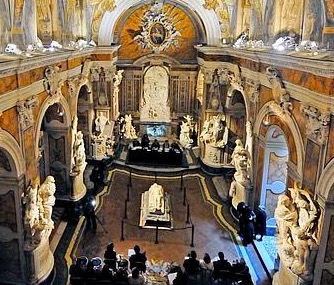
So why not a Triad of?:
• Sincerity
• Veiled Christ
• Sweetness of the Marital Yoke
Or why not a pentad of?:
• Chasity/Modesty
• Disillusion
• Sincerity
• Sweetness of the Marital Yoke
• Veiled Christ
I hate being that guy,......
But after doing a little research, all of the sinister aspects of the story vanish with the light of truth. I guess that's what happens when we take The Vigilant Citizen as source material.
Before I begin, I do sincerely thank you for organizing this thread and making me aware of this stunning chapel and its amazing works of art.
"Before it was transformed by Raimondo di Sangro, the Sansevero Chapel was already the subject of bizarre rumors."
Duke of Torremaggiore, Giovan (John) Francesco di Sangro, commissioned the construction of the Chapel of Sansevero around 1590. It was originally named; "Santa Maria della Pietà", in honor of the Virgin Mary, not Isis.
An inscription over the main entrance of the complex, which reads:
“Alessandro di Sangro, Patriarch of Alexandria built this temple, dedicated to the Blessed Virgin, as a tomb for himself and for his family in the year of Our Lord 1613”.
Legend says that the Chapel of Sansevero was built at the location of an appearance of the Virgin Mary.
Cesare d’Engenio Caracciolo tells in his Sacred Naples of 1623 that, in around 1590, an innocent man who was being led to prison in chains passed before the garden of the di Sangro palace in Piazza San Domenico Maggiore, and saw a part of the garden wall collapse and an image of the Madonna appear. He promised the Virgin Mary to offer her a silver lamp and a dedication if only his innocence might be recognized. Once released, the man was faithful to his vow. The sacred image thus became a place of pilgrimage and prayer, and many other graces were received there.
Shortly afterwards, the Duke of Torremaggiore, Giovan Francesco di Sangro, seriously ill, turned to the Madonna to plead for his recovery. Miraculously cured, he erected in thanksgiving a “small chapel” called Santa Maria della Pietà or Pietatella in the place where the venerable image had first appeared (still visible above the High Altar).
Giovan (John) Francesco's son; The Patriarch of Alexandria, Alessandro di Sangro, converted the chapel into a family mausoleum in 1613.
Finally, during the mid-18th Century, Raimondo di Sangro expanded the family mausoleum and commissioned great artists, painters, sculptors, and craftsmen to ornament the mausoleum with beautiful works of art.
"It was said to have been constructed on an old temple of Isis"
"Locals claim the location of The Chastity is exactly where the Isis statue was when the temple was an Isis temple."
The Iseum Campense was actually located at the Campus Martius, which is about 140+ miles north of the Chapel of Sansevero. The Temple of Isis in Pompeii is 16 miles to the south of the Chapel. I have found no mention of a Temple of Isis in Naples.
"to prove this fact, locals point to a massive Statue of the God of the Nile, located just around the corner from his home."
The Statue of the Nile God has nothing to do with the Sangro Family. It is a Hellenistic statue created during the 2nd to 3rd Century. It features the personification of the Nile, and is speculated to have been brought to Naples to correlate its symbolism as a seaport town.
The statue represents the Nile God, recumbent with a cornucopia and lying on a now mutilated sphinx.
The Statue of the Nile God is 500 feet away from the Chapel of Sansevero, and is positioned in front of the church of Santa Maria Assunta dei Pignatelli. Therefore, using The Vigilant Citizen's vicinity approach; The Statue of the Nile God should be connected to the Pignatelli Family, not the Sangro Family. However, this is also incorrect, as this statue is simply a historic monument.
"Put the three together and what do you get?"
"these three sculptures constitute an “esoteric triangle”. With The Chastity on the left (representing the female principle), Disillusionment on the right (representing the male principle) and Veiled Christ in the middle (representing the “perfected man”), the sculptures esoterically represent the most fundamental hermetic principle: Duality merging to create a perfected being.
In occult circles, this concept is personified by Isis and Osiris uniting to create Horus – the perfect being."
So says The Vigilant Citizen in his/her own words from his/her own opinion.
As stated by the Museum's website, those three sculptures are the most intricate and skillfully crafted of the chapel's works of art, and have become the most favored and well-known amongst experts and tourists:
Modesty
"With the Veiled Christ and Disillusion, Modesty makes up the triad of artistic excellence in the Sansevero Chapel, as sanctioned by travellers, guides and art historians since the seventeen hundreds."
In addition to the "Veiled Christ", there are actually 10 sculptures representing ten different Virtues, and 10 monuments memorializing Sangro Family members.
Statues of Virtues
"Divine Love"
"Decorum"
"Disillusion"
"Self-Control"
"Education"
"Liberality"
"Modesty" ("Chasity")
"Sincerity"
"Sweetness of the Marital Yoke"
"Religious Zeal"
The Vigilant Citizen has cherry-picked which statues to draw meaning from, because the "Veiled Christ Statue" is actually situated between the statues symbolizing the Virtues of "Sweetness of the Marital Yoke" and "Sincerity".


So why not a Triad of?:
• Sincerity
• Veiled Christ
• Sweetness of the Marital Yoke
Or why not a pentad of?:
• Chasity/Modesty
• Disillusion
• Sincerity
• Sweetness of the Marital Yoke
• Veiled Christ
edit on 5/31/17 by Sahabi because: (no reason given)
new topics
-
Electrical tricks for saving money
Education and Media: 1 hours ago -
VP's Secret Service agent brawls with other agents at Andrews
Mainstream News: 2 hours ago -
Sunak spinning the sickness figures
Other Current Events: 3 hours ago -
Nearly 70% Of Americans Want Talks To End War In Ukraine
Political Issues: 3 hours ago -
Late Night with the Devil - a really good unusual modern horror film.
Movies: 5 hours ago -
Cats Used as Live Bait to Train Ferocious Pitbulls in Illegal NYC Dogfighting
Social Issues and Civil Unrest: 6 hours ago -
The Good News According to Jesus - Episode 1
Religion, Faith, And Theology: 8 hours ago -
HORRIBLE !! Russian Soldier Drinking Own Urine To Survive In Battle
World War Three: 10 hours ago
top topics
-
SETI chief says US has no evidence for alien technology. 'And we never have'
Aliens and UFOs: 17 hours ago, 8 flags -
Cats Used as Live Bait to Train Ferocious Pitbulls in Illegal NYC Dogfighting
Social Issues and Civil Unrest: 6 hours ago, 8 flags -
Florida man's trip overseas ends in shock over $143,000 T-Mobile phone bill
Social Issues and Civil Unrest: 13 hours ago, 8 flags -
VP's Secret Service agent brawls with other agents at Andrews
Mainstream News: 2 hours ago, 7 flags -
Former Labour minister Frank Field dies aged 81
People: 15 hours ago, 4 flags -
Bobiverse
Fantasy & Science Fiction: 13 hours ago, 3 flags -
HORRIBLE !! Russian Soldier Drinking Own Urine To Survive In Battle
World War Three: 10 hours ago, 3 flags -
Nearly 70% Of Americans Want Talks To End War In Ukraine
Political Issues: 3 hours ago, 3 flags -
Sunak spinning the sickness figures
Other Current Events: 3 hours ago, 3 flags -
Late Night with the Devil - a really good unusual modern horror film.
Movies: 5 hours ago, 2 flags
active topics
-
Cats Used as Live Bait to Train Ferocious Pitbulls in Illegal NYC Dogfighting
Social Issues and Civil Unrest • 13 • : Albone -
Spectrophilia - Women Who Have Had Affairs With Ghosts Say Spooks Are Better Lovers Than Real Men
Paranormal Studies • 31 • : charlyv -
HORRIBLE !! Russian Soldier Drinking Own Urine To Survive In Battle
World War Three • 29 • : doubledan717 -
-@TH3WH17ERABB17- -Q- ---TIME TO SHOW THE WORLD--- -Part- --44--
Dissecting Disinformation • 651 • : 777Vader -
VP's Secret Service agent brawls with other agents at Andrews
Mainstream News • 19 • : NoCorruptionAllowed -
VirginOfGrand says hello
Introductions • 5 • : burritocat -
The Reality of the Laser
Military Projects • 44 • : Zaphod58 -
SETI chief says US has no evidence for alien technology. 'And we never have'
Aliens and UFOs • 42 • : Boomer1947 -
NASA Researchers Discover a Parallel Universe That Runs Backwards through Time - Alongside Us
Space Exploration • 71 • : charlyv -
Sunak spinning the sickness figures
Other Current Events • 4 • : annonentity
